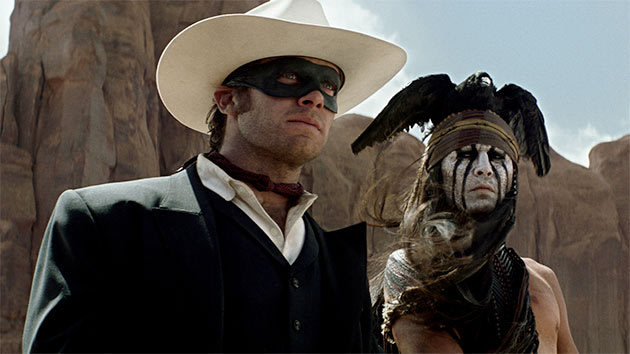
The Lone Ranger’s greatest accomplishment is making two and a half hours feel closer to five hours and thirty-eight minutes. Replete with a conglomeration of camp, shallow investigations of morality, wonky stabs at translating a complicated history between Native Americans and settlers, and overall stock characters, the film has issues – issues that made it a low-grossing bomb over its opening weekend and issues that will probably end up costing the filmmakers $190 million in the United States market.
Beginning in San Francisco in 1933, we follow a boy through a carnival. Wandering through the various tents, he stumbles upon one that brings him into the Old West, and he comes face to face with a life size diorama of “The Noble Savage,” Tonto (Johnny Depp). Here, the film goes inexplicably mystical when the boy discovers that the presumed wax statue is actually alive and here to relate the story of the origin of the Lone Ranger.
The most logical question that arises here is “What happened to the original wax statue?” Or, is Gore Verbinsky being more meta than he’s receiving credit for? Is he possibly suggesting that the Native Americans are still being used as pawns for our entertainment? Are they relegated to the corners are various generations of pop culture?
If so, The Lone Ranger is more of an exemplar of this practice than it is a protestor, particularly in the way that Tonto is depicted. He is at once a man post-nervous breakdown and the wisest man in the film. He is torn between two realities, one that forces him into isolation and away from the settlers, and one whose people settled the territories. But, most often, this comes across as camp as he feeds the dead crow perched atop his head.
Despite this, Tonto is the most complex character in a cast of shallow shills leading us through a rather pedestrian battle between Cowboys and Indians. This time, the Cowboys have transitioned to the Texas Rangers, a name that, today, is more affiliated with honor and heroics (I suppose we can thank Chuck Norris for this)than with their history as an often-rogue group known for terrorizing Indians just as much as they upheld peace.
The screenplay could have been profound had it stuck to these moments in history. It could have been a worthwhile romp with a message, but then it went back to the mystical when it introduced “Windingo,” an evil spirit that throws the world off balance. Fuzzy bunnies grow razor sharp teeth and become carnivorous hunters. They cannibalize one of their own that Tonto is cooking on a spit. Even here something clever could have been done. If elaborated upon, it becomes a fine look at the use of the word “savagery.” Wherein Tonto and the other Native Americans are savages, the American expansion via the railroad is depicted equally as savage. As do the actions of corrupt politicians and lawmen.
In other words, savagery is euphemized as expansion and growth when done by the majority. It remains savagery when utilized by those nuisances that stand in the way of progress.
There’s something doubly eerie about this film’s current failure at the box office. It means nothing. Disney stock has risen since The Lone Ranger’s debut, and this bomb is right on the heels of another M. Night Shyamalan disaster, After Earth. Yet, Disney is rubber, or Teflon, or Kevlar. They’re empire is so large that they’ve reached the point where movies hardly matter. Guaranteed paychecks stream from Pixar, ABC, and most of all ESPN. The most recent Disney films have transitioned from tentpole to pop-up tent. Like the boy who wanders through the carnival and stumbles upon the Old West tent, we are led to believe that we are in for a treat, or an intriguing adventure, but instead, we are left with a mishmash of clichés and tropes. The characters are often re-runs, or more often inexplicable. The story is shallow, which leaves us learning nothing and only thinking that we should have spent out $12 more wisely.





